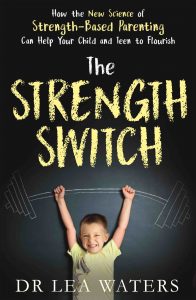
Dr Lea Waters demonstrates in her new book The Strength Switch how optimism, resilience and achievement can be encouraged by focussing on kids’ strengths, rather than correcting their weaknesses. How can schools can bring about a ‘strength-based cultural shift’?
Suzy Barry: Can you briefly describe your research on wellbeing in schools? What did you find?

Dr Lea Waters: I have evaluated the effects of various positive psychology curriculums on student wellbeing. The curriculums have been designed to help students learn a range of psychological skills that help to increase gratitude, mindfulness, use of strengths, kindness and resilience. The research shows that these programs significantly improve a range of wellbeing outcomes for students including increases in optimism, self-esteem, self-acceptance, and life satisfaction as well as reductions in stress, anxiety and depression. In some studies, wellbeing programs have also been shown to improve academic grades.
SB: Are these issues that can be addressed via a strength-based culture? What is this ‘strength-blindness’ how can it be ‘cured’?
LW: A strength-based culture has four key benefits:
- Higher performance and greater likelihood of reaching one’s potential: when schools put the bulk of their resources into lifting low performance (either in students or staff) a lot of effort is spent to moving from poor to average. When we work on weakness we can only take our kids to a point where the weakness no longer exists. It’s when we work on strengths that we get them to high performance.
- Diversity and inclusion: everyone has unique strengths and when we adopt a strength-based culture we get to see the differences in others from an appreciative perspective. We also get to utilize people’s strengths more intentionally, in order to have each staff member and each student contribute to a positive culture. We bring together all strengths – the communicators, the problem solvers, the energisers, the analysers, the change agents, the relationship builders, the creatives and so on – and each person is valued for what they add.
- Wellbeing: research shows that when teachers and students play to their strengths it boosts a range of wellbeing outcomes such as life satisfaction, positive emotions and optimism.
- Fosters better teacher-student bond: Strengths provide a positive common ground for teachers and students to connect because they both have strengths. Teachers and students bond when they find they have similar or complementary strengths. When they have different strengths, they can appreciate the differences. Strengths break down hierarchy – they are a social equaliser because everyone has them. In one school, students engaged in a week of ‘strengths spotting’ of their teachers. They wrote down the strengths they saw in their teachers and these messages were then displayed on the electronic board across the school examples included:
“Mr Green always displays his strength of humour. He plays birthday music for our birthday and we all sing along” and “Ms Berg is really persistent. She told me that it was her mission to get me to love and understand maths. She continues to ask if I am ok and if I need help.”
Strength blindness is the term that psychologists use to describe the phenomenon of people not seeing their strengths clearly. Strengths are the things we perform well, are energised by, and are self-motivated to do. Our strengths come naturally to us and, thus, require less effort to use, than our weaknesses. As such, we tend to take our strengths for granted and we become blind to them – not seeing them as strengths and assuming everyone has the same qualities as us. The downside of strengths blindness is that we then don’t think to use our strengths intentionally to build our wellbeing and performance.

SB: How can school leaders / teachers implement the concepts discussed in your book?
LW: The two key processes in my book for strength-based parenting are first learning how to see strengths in yourself and others; then learning how to build strengths in yourself and others.
These two processes are equally relevant in schools as they are in families. The book shows parents how they can better see and use their own unique strengths in their role as a parent and my research shows that when parents do this, they have higher self-efficacy and more positive emotions. The same would apply for teachers. All the surveys, exercises and activities in the book can be used and adapted to the classroom and I have woven an number of teacher stories throughout the book.
SB: You indicate that parents need to let their kids ‘slack off’ sometimes – should teachers give students ‘down-time’ at school as well? Why/why not?
LW: Yes, when teachers structure down-time into their classes, rather than fill the class time with formal instruction, they are actually helping their students to learn. This might seem counter-intuitive, but neuroscience now shows that when students slow down and turn inwards, although they don’t look busy on the outside, their brains are actually super busy and fully firing.
When the brain’s external-focused, task-mode turns off, an alternate mode in the brain turns on. Neuroscientists have labelled this mode the ‘ Default Network Mode’. Down time shifts a student’s brain into the Default Network Mode – DFM for short – which is critical for learning because it is when we are using our DFM that the brain pauses to:
- integrate information;
- consolidate learning;
- process emotions;
- clear ‘cerebral congestion’,
- and refresh and restore our brain’s capacity for attention.
So, building in down-time, play, mindfulness and opportunities to slack off in class are an important part of helping students learn.
Basically, our brains use down-time to untangle and order all the thoughts and feelings we’ve had that day. Downtime helps us clear our ‘cerebral congestion’. This is as necessary for teachers and all school staff as it is for students.
SB: How can strength-based practices be of use when working with students with specific challenges?
LW: Strengths are a powerful way to build confidence and wellbeing in kids who have learning challenges or who sit along the spectrum. Research on positive parenting with children who have attention deficit/hyperactivity disorder (ADHD) shows that while it doesn’t change their deficit disorder, it does improve their behaviour. ADHD children whose parents use praise, positive emotions, physical affection, and positive engagement as regular features of their parenting have fewer conduct problems, fewer mood issues, fewer sociability problems, and less hyperactivity.
One mother in my book described to me how discovering the core strengths of her son, who has Asperger’s syndrome, allowed her to see his powers of observation of others’ emotions that hadn’t been as noticeable before:
“Fin has Asperger’s syndrome, so it was a surprise to me that he has social intelligence as a signature strength. I didn’t really believe it until I asked others who know him well. His teachers said it made perfect sense to them—Fin notices details that others don’t and is very perceptive of others’ emotions, even though he may not always respond or know what to do with that emotion. Seeing that this was a strength for Fin helped me to understand that he could observe people’s emotions but needed help on appropriate responses. Sometimes when he has friend over, he’ll tell me the friend feels “uncomfortable” and he’ll explain what he sees in the friend’s face. Then we talk and he can think about how to help resolve the situation.”
SB: Schools can only do so much – do you have some suggestions for engaging and educating parents to support you in your strength-based culture?
LW:
- Introduce parents to the strength-based approach through a parent night.
- Start parent-teacher session by identifying the strengths you see in their children.
- Incorporate strengths-spotting into the student diary. Have a section where the students record the strengths they used that week and parent sign off on it.
- Bring strengths into the parent newsletter: have a strength of the month and showcase examples of where students and staff have used that strengths
- Include strengths into the school’s mission and purpose statements
- Integrate strengths into report cards, school assemblies and sports reports
- Provide parents and teachers with opportunities to learn more deeply about strengths through the Strength-Switch course that can be facilitated at your school.
SB: What about those weaknesses. Do we just ignore them? Won’t that mean they won’t progress?
LW: Taken a strength-based approach is not about ignoring weakness, these still need to be addressed. But when you come first from strengths, you’ll naturally find more constructive ways to deal with weaknesses and this is for two reasons:
- The student knows that you see the good in them and that you’re on their side; they know you see them in a balanced way – good and bad. This means they are more open and less defensive to you helping address their weak spots and poor behaviour.
- Sometimes you can use a strength to help address a weakness. If you have a student who is struggling academically but has high persistence, you can help them through the learning challenges by drawing on that strength. If you have a class clown who is disruptive, look for a strength in them and channel that. Maybe they have humour but are misapplying it or maybe they’re very social, or even have leadership, but are using these the wrong way. Connect them to their strength and show them how to use it in ways that work for them rather than against them.
The Strength Switch by Dr Lea Waters is published by Penguin Random House Australia.







